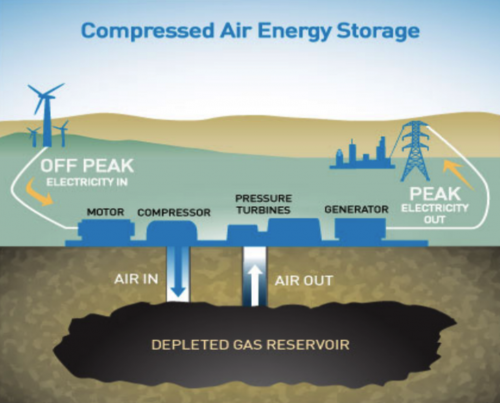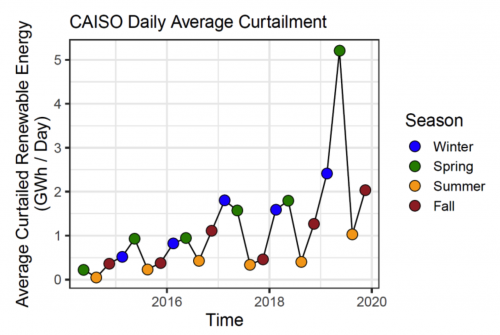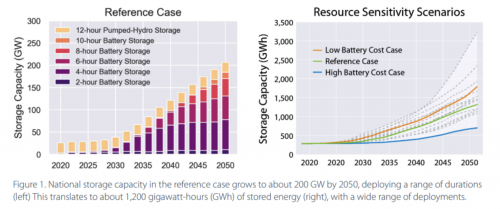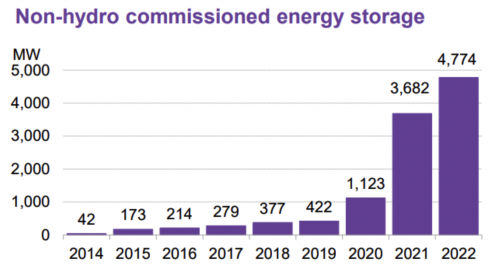Energy Storage
Background on energy storage
When power goes out to a neighborhood, people who reach for a flashlight are taking advantage of energy stored in small, portable batteries. Utilities, too, depend on energy storage to maintain stable, reliable electricity service by helping match supply and demand over time scales from seconds to weeks. Failure to keep supply in sync with demand can lead to problems ranging from voltage spikes to costly regional blackouts.
Electricity is a remarkably flexible form of energy, but it generally can’t be stored without first converting it to some other form of energy, such as heat, gravity, pressure, or chemical bonds. That energy can in turn be used to generate electricity, with some inevitable loss of energy in the round trip.
As utilities come to rely increasingly on cheap, clean, and intermittent renewable energy, they are looking for more and more cost-effective ways to store energy. For example, extra energy generated by solar panels during the daytime would ideally be stored and used at night. Unlike batteries in electric vehicles, utility storage doesn’t have to be particularly compact, lightweight, or capable of providing dramatic surges of power. It does need to offer low cost per unit of energy, low maintenance costs, a long operating life to amortize capital costs, and safe, non-polluting operation.
Source: BloombergNEF
Examples of major storage technologies include:
- Pumped-hydro storage. This efficient, gravity-based system still accounts for two-thirds of the utility storage market. It typically involves two reservoirs connected by pumps and water channels. When demand sags, the utility can use surplus electricity to pump water from the lower reservoir to the higher one. When demand surges, the utility can release water from the upper reservoir to drive turbine generators.
- Compressed air energy storage. Using pressure instead of gravity, this storage system uses electricity to pump air (or liquids) into a cavern under pressure. When released, the air drives a turbine generator. This mechanical technology can store large volumes of energy and convert it to electricity reasonably efficiently.

Source: Pacific Gas and Electric Co. and California Energy Commission
- Thermal energy storage. Heat drives most of today’s electricity generation, but it doesn’t have to be provided by fossil combustion or nuclear reactions. Electricity can be used to create reservoirs of heat (like molten salt or hot sand) or cold (like liquid air). “Heat engines” can then use gases or liquids that flow from hot to cold reservoirs to drive turbine generators. Stored heat can also be used to directly serve nearby buildings.
- Batteries. Thanks to plummeting costs, lithium-ion batteries, like those used in electric vehicles, are often cost-effective for utility applications up to four hours. For longer duration, research labs and start-ups are developing a host of lower-cost alternatives for this growing market. At least two companies now offer batteries based on cheap, plentiful, and relatively benign iron to store energy for hours or days. Researchers are also experimenting with batteries based on other inexpensive elements such as sulfur and sodium.
- Hydrogen. Unlike fossil fuels, hydrogen combustion does not produce CO2, but few known natural reservoirs exist. Surplus renewable electricity can create it by splitting water into hydrogen and oxygen atoms (electrolysis). The hydrogen can then be stored, transported, and used to generate electricity using fuel cells.
- Gravity storage. Similar in principle to pumped hydro storage, the earth’s gravity can also be put to work raising and lowering massive objects like concrete blocks, a concept referred to as a gravity battery.
How energy storage supports a clean and stable electric grid
Renewable wind and solar energy are clean and highly affordable, but their variability poses a challenge to utilities that must match electric supply and demand in real-time to prevent service disruptions. Energy storage can permit greater utilization of renewable electricity by providing backup power when wind and solar don’t deliver. Storage facilities can also rescue the grid from unusual but catastrophic failures of fossil and nuclear generation.
The good news is that stored energy can be replenished with cheap surplus renewable electricity that would otherwise be wasted (“curtailed”) when generation exceeds demand. The value of putting such surplus energy to good use will grow year by year as increasing amounts of wind and solar energy are curtailed. In 2021, Texas curtailed almost as much solar energy as a gigantic 1 gigawatt (GW) solar plant would produce in a year. The clean energy lost in California to solar and wind curtailments in the first 10 months of 2022 could have powered 412,000 average homes if stored and put to use another time.

California solar curtailments. Source: Lawrence Berkeley National Laboratory
Issues with energy storage
To avoid major rate increases for electricity, the cost of storage must plummet to become competitive with natural gas plants, which today provide most of the flexible generation to address the variability of wind and solar power. Fortunately, improvements in technology and economies of scale should drive costs down dramatically over the next few years, as happened with the battery market for electric vehicles. To help meet that challenge, the Department of Energy in 2022 set a priority national goal to slash the cost of long duration energy storage by 90% within the decade.
With passage of the Inflation Reduction Act, grid storage systems are now eligible for a 30% investment tax credit, and if they meet special labor and community development requirements, additional incentives up to 70% of the project cost. According to battery storage developer Convergent Energy and Power, “This change will likely drive up to $1 trillion in storage investments by the early 2030s.”
Challenges remain, however. The most popular form of storage, pumped hydro, is severely limited by the number of suitable reservoir sites. Other forms of storage have yet to be fully proven because until recently the market for long duration storage was small. Compressed air storage looks promising but just two commercial plants exist today. Many startups promise new thermal storage systems or inexpensive batteries, but they must prove themselves before utilities put their trust in them. Hydrogen holds promise but costs remain high to produce it cleanly and the infrastructure to transport and store it will be challenging to create.
How much could energy storage contribute to a clean and stable electric grid?
Around the world, storage capacity in 2020 was sufficient to supply only three hours of electricity consumption. For a future based mostly on renewable energy, that capacity must be increased first to days and then to weeks to ensure reliable service.
A roadmap to 100% clean power by 2035 issued by NREL projects the need to install up to 350 GW of multi-hour energy storage and up to 680 GW of multi-day storage. In 2020, the entire storage capacity in the United States amounted to just 23 GW. Alternatively, a net-zero-by-2050 scenario issued by Bloomberg NEF in 2021 requires a 176-fold increase in total capacity by the end of the decade. Needless to say, research and development (R&D) investments and capital spending must skyrocket to make that happen.

Source: Estimated need for diurnal storage capacity (<12 hours). NREL, Storage Futures Study, 2022.
Other FAQs
Can EV batteries help meet utilities’ storage needs?
As millions of Americans discover the practical (as well as environmental) virtues of electric vehicles, they will inevitably acquire large and highly capable batteries that sit idle much of the day. The collective storage capacity of these batteries can represent a tremendous resource for utilities–and a side source of income for EV customers who make their car batteries available. So-called “vehicle-to-grid” applications are still being tested, but some vehicles like the Ford F-150 Lightning Electric are already being designed to serve this purpose. In addition, the consulting firm McKinsey projects a huge market in utility storage applications will develop for “second use” batteries that no longer meet driver needs but still retain about 80% of their original capacity. A 2023 study in Nature Communications projects that EV batteries alone could meet all short-term storage needs of utilities as early as 2030.
How bad are batteries for the environment?
All forms of energy storage, like all forms of energy generation, have an environmental footprint. Batteries require mining and manufacturing that disturb ecosystems, create carbon emissions, and can even pose political challenges. However, numerous lifecycle studies of EVs, including their battery manufacture, conclude they have much smaller climate footprints than combustion cars over a normal lifespan. In the case of utility storage, putting existing EV batteries to work, as described above, causes no additional environmental harm. (Similarly, turbine generators can be added to existing dams to generate hydropower with virtually no additional carbon footprint.) Moreover, many specialized batteries designed for utility applications use common elements like iron, which can be mined and processed with much less environmental impact than some more exotic metals needed for car batteries.
